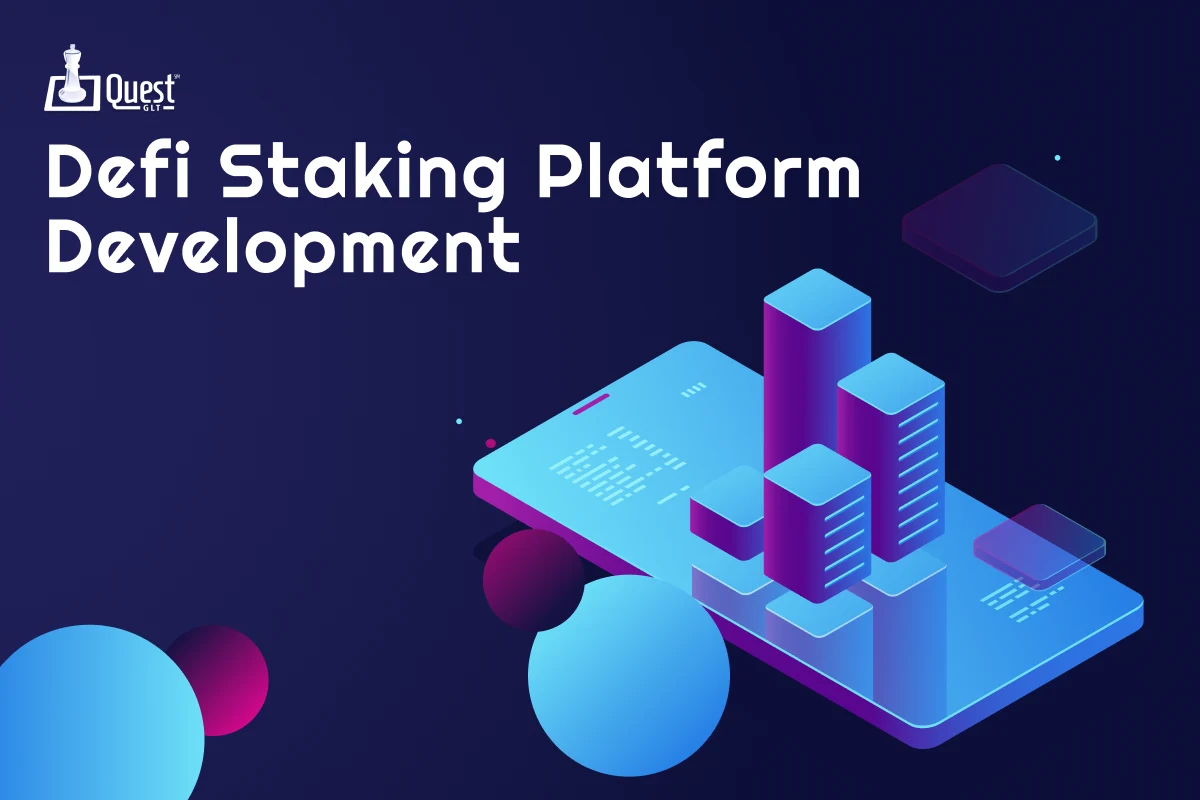
One of the most intriguing new features of blockchain technology is the formation of cryptocurrency-based financial models. For example, a model called DeFi Staking allows a user to lock their coins on a decentralized exchange (DEX) to generate either profit from yield farming, liquidity mining, or liquidity provisioning. These transaction activities not only guarantee the exchange process as well as the potential to borrow but also offer the stalker some incentives. The objective is to make money by generating more cryptocurrency, which can be considered similar to getting dividends from stocks or interest from savings accounts.
The phenomenon that is DeFi Staking happens with the process of staking your cryptocurrency for liquidity provision, the process of yield farming, and also the process of liquidity mining. There are three main phases in DeFi Staking Platform Development: security testing, crypto wallet creation, and smart contract development.
Cryptocurrency has changed the entire economic makeup. Now, it is not for the rich and famous alone. Anyone with a dream can succeed. Compared to real estate or private equity, the cryptocurrency market is open to everyone. And certainly, it is for investors, traders, startups, and business owners, as well as others.
For a while, cryptocurrencies had a daily trading volume of $27.7 billion, which is roughly equivalent to a trillion dollars. On average, DeFi accounts for 5% of that total, or $5 to 6 billion dollars a day it brings in.
The new study shows that DeFi’s entire value of all assets locked is approximately $50 billion. Being equivalent to the DeFi space’s stability across all of its protocols, the security of these networks is one of the most important factors. Staking, farming, and liquidity provisioning, which is represented by the backing value locked (TVL), dominate this. That's the reason why we have decided to talk about DeFi Staking in this particular blog.
If you want to create a financial platform that is based on this paradigm, you have to begin with an understanding of what DeFi is and its construction.
What is DeFi Staking?
Staking is a process in which users lock up their cryptocurrency tokens to maintain the network in exchange for rewards, often known as DeFi Staking. Staking is one of the main components of many decentralised networks, as it provides protection for the network and leads the members of the community to accumulate and exploit cryptocurrencies.
Understanding the DeFi Staking Platform in Detail
A decentralised platform known as the DeFi staking platform provides users with the power to lock up their Bitcoin investments for a limited period in return for dividends. It assists projects to incentivise long-term commitments from token holders. Staking allows users to participate in the platform's token supply dynamics while collecting incentives based on the number of assets they stake. By staking, users vigorously contribute to the network's integrity and resilience, potentially boosting their holdings via accumulated bonuses. This technique not only encourages long-term asset retention but also strengthens the sustainability and overall functionality of the platform.
Important Features of DeFi Staking Platforms
It is important to understand the DeFi staking platform’s core components as a basis. In this blog, we will take a look at vital processes that impart the viability and profitability of DeFi staking development.
-
Secure Smart Contracts
This will be the prerequisite for any DeFi staking service. These contracts implement staking, reward distribution, and other protocol features. It is a matter of principle to make sure that smart contracts are reliable and infallible, given the fact that any shortcomings or vulnerabilities might not only bring considerable financial damage to users but may also damage the company’s reputation. To achieve comprehensive code audits, rigorous testing and continuous security audits are necessary for the reduction of risks while building trust among all stakeholders.
-
Straightforward User Experience
Usability and ease of use are fundamental success factors for the adoption and retention of DeFi staking platforms. Along the process of constructing a team, controlling staking activities, and acknowledging the members' rewards, the UI of the platform should be key, simple, and visually appealing. Plain and understandable instructions for use, the latest data reports in real-time, and a seamless user experience will generate user engagement and satisfaction, which will further contribute to platform popularity and encourage community participation.
-
Versatile Staking Options
Information about various staking options should be available in DeFi staking platform development so that users can choose what type of staking they need and how they want to do it. Staking platforms within DeFi should not provide a single kind of staking period, staking amount, or structure of incentives to attract both non-professional and institutional investors. On top of that, functionality like unstacking tokens and changing the staking parameters should be accessible on demand, so users would find it much easier to control their stakes and get the most out of market movements.
-
Sustainable Tokenomics Model
The daily staking scheme has not only brought out participation but also kept the token value from declining and ensured the operating stability of the DeFi staking platform. Economic modelling and research, especially on staking incentive balance, inflation rates, and token issuing, need to be done extensively. To reach the objective of providing incentives but also promoting healthy ecosystems, the usefulness and scarcity of the token should be compared at the very beginning.
-
Integration and Interoperability
Nowadays, due to the constantly changing nature of DeFi, the ability to operate in a linked environment has become crucial for DeFi staking platform design. On the flip side, users will get a group of other DeFi protocols, decentralised exchanges, and liquidity pools where they are connected without glitches, and all this increases liquidity, accessibility, and utility.
How Does a Defi Staking Platforms Work?
In this section, we take you through a step-by-step guide to how these platforms operate, explaining their inner workings and, hence, giving you the confidence that enables you to understand and interact with DeFi staking.
-
Connect a Wallet
The first step is for the user to link their Bitcoin wallet to a DeFi staking platform. This wallet will serve as a passage for users to access and utilise their digital assets. Whether a user uses a hardware wallet, software wallet, or browser extension, the user must always secure their link to the staking platform to ensure safe and easy access to their assets.
-
Pick a Staking Asset
After the wallet is linked, users will be provided with a list of staking assets approved by the platform. Customers may choose from assets to be staked based on possible returns, criteria, and individual investing techniques.
-
Stake Tokens
Having picked up the staking asset, users place their tokens on a DeFi platform for staking. This means putting a particular amount of such token(s) within the forum's smart contract.
-
Earning Incentives
The potential lenders get new tokens immediately for their contribution. This is largely through the ownership of mined cryptocurrency they staked. The remuneration on many occasions, is dependent on the factors that include holding time of staking and the number of tickets staked.
-
Track and Vote for Blocks Production
The DeFi staking platform may provide a UI with which the users will be able to track & manage the activity at every stage once the period has started. This entails appraising the efficiency, searching for rewards, and adjusting the parameters when it is necessary. Customers will be able to wager their tokens or alter settings at their pleasure, which will enable them to decide what their staking portfolio and investment strategy will look like without profound limits and rules.
Benefits of Developing a DeFi Staking Platform for Your Crypto Projects
-
Improved Token Demand and Value
Offering staking options allows crypto projects to boost the demand and scarcity of their native coins. Staking incentivises token holders to lock up their tokens for a certain length of time, limiting the circulating quantity and increasing scarcity. This, together with the usefulness and advantages of staking, makes the token more appealing to investors and boosts its value proposition in the marketplace.
-
Community Involvement and Encouragement
DeFi staking platform development promotes community involvement and empowerment by allowing users to participate in network operations and governance. Staking their tokens allows users to actively participate in network growth and decentralisation. This sense of ownership and engagement enhances the project's environment, increases community trust and loyalty, and promotes a collaborative and inclusive community culture.
-
Distinctive and Competitive Advantage
In this competitive industry, providing a staking platform distinguishes crypto ventures and offers customers a distinct value proposition. DeFi staking platform development distinguishes a project's dedication to innovation, decentralisation, and community empowerment, setting it apart from rivals and attracting investors and users looking for passive income and involvement in decentralised finance. Staking platform development allows projects to differentiate themselves in the market and achieve a competitive edge.
Staking vs.Farming: Understanding the Difference
Staking and farming are the two most popular user reward attainment methods for the network's operation. Discerning the difference between staking platform development and farming platform development plays a significant role for crypto companies that are interested in efficiently exploiting profit opportunities within the realm of DeFi ecosystems. In this part, we will be exploring the differences between staking and farming as well as outline their features. Our explanations are intended to help crypto projects understand what is staking and farming.
Highlighting the Main Differences
Aim: Staking aims to put pressure on the token release schedule, i.e., limit the supply and boost user participation, while in farming, the limit is the return from liquidity provision and heightened trading activities.
-
Mechanism: As for staking, you lock your tokens in a smart contract, and this is not the case with farming, as you lock liquidity provider tokens—LLP tokens—which you obtain by contributing liquidity to the liquidity pools.
-
Users' Risk Level: In most cases, locking is considered a less risky option because there is mostly a case of moving assets to a wallet with an established protocol in it, whereas farming of this type may become the riskier one because there may be impermanent losses, smart contract problems, and protocol changes promptly.
-
Reward Type: Also, staking efforts often yield tokens as rewards. On the other hand, farming payments may come in the form of tokens, fees, or interests, which are determined by either the protocol or platform.
-
User Engagement: The staking process is one of the methods used to foster long-term token conservation that will, in turn, be an asset for all community members who will be loyal to and active in the market. Meanwhile, farming is associated with sharing seekers who just want their coins for a week, looking for opportunities to trade their coins, and churning cash flow without true long-term value.
Things to Consider in DeFi Staking Platform Development
-
Safety Measures
Stability and reliability should have been verified in critical infrastructure with smart contracts to be sure that security was done properly. Breadth-wise, comprehensive code audits, rigorous testing, and the due process of continuing security assessment would help to decrease the probability of bugs, vulnerabilities, and threats. Adoption of the most advanced secure smart contract templates along with compliance by the standards of the industry in cybersecurity assists in the security of not only the user's saved money but also lays the basis for the platform's respectability and reliability.
-
Scalability
The ability to scale DeFi services is vital development as the need for these services increases henceforth the users. The platform must possess the essential power of handling an increased number of transactions, interactions with users and heightened level of network activity while sustaining performance and efficiency. Using scalable blockchain technologies together with layer-2 solutions and gas optimisation could help our platform grow and improve further beyond our expectations.
-
Integration with Other DeFi Protocols
Growing in an interconnected DeFi ecosystem becomes indispensable for the building of DeFi staking systems as network compatibility with various protocols and platforms is pivotal to this process. Users enjoy the omnipresent feature of DeFi which synchronizes their services with other DeFi protocols such as decentralized exchanges, lending platforms, and others, which in the long run increases liquidity, accessibility, and utility.
Concluding Thoughts
The market of DeFi staking platform development has been a competitive one so far with plenty of investors as well as users who are interested in not only staking their coins but also earning rewards by staking. Such platforms have multifarious impacts like increased token value and high demand, community empowerment, and unique advantages that competitors cannot afford. While the construction of DeFi staking platforms requires a deep knowledge of blockchain technology, smart contract development, and user interface design, it also provides opportunities for the development of financial products and enhances financial inclusivity for the unbanked. DeFi Staking Platforms’s future is phenomenal with enormous growth prospects and innovation technology in the loop.













